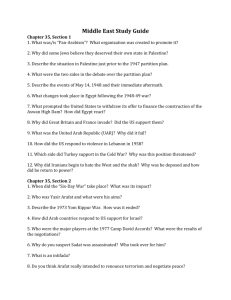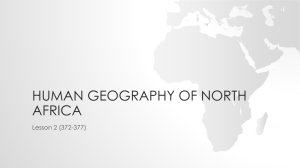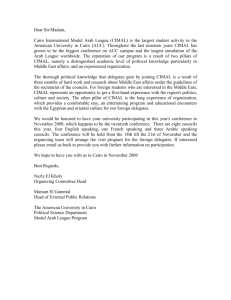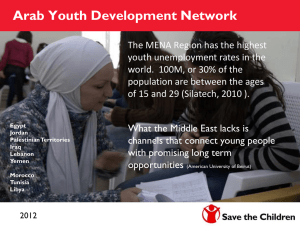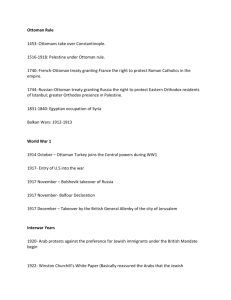EQ 2: How has modern nationalism affected African and Arab
advertisement
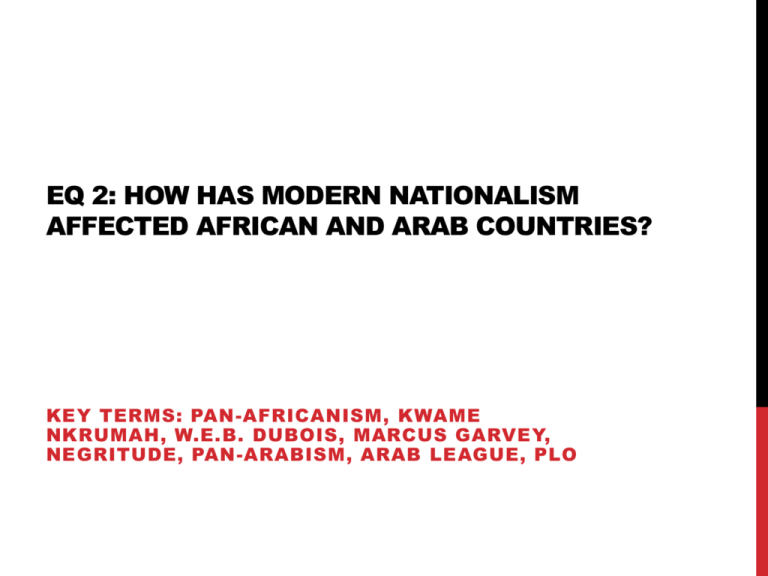
EQ 2: HOW HAS MODERN NATIONALISM AFFECTED AFRICAN AND ARAB COUNTRIES? KEY TERMS: PAN-AFRICANISM, KWAME NKRUMAH, W.E.B. DUBOIS, MARCUS GARVEY, NEGRITUDE, PAN-ARABISM, ARAB LEAGUE, PLO PAN-AFRICANISM • Pan-Africanism was about unity, shared identity, and cultural heritage of people of African descent. • These ideas were expressed by writers like W.E.B. Du Bois and Marcus Garvey. • Kwame Nkrumah, the founder and first president of the modern nation of Ghana, was one of the most influential Pan-Africanists of the 20th century. Kwame Nkrumah “Africa is a paradox which illustrates and highlights neo-colonialism. Her earth is rich, yet the products that come from above and below the soil continue to enrich, not Africans predominantly, but groups and individuals who operate to Africa’s impoverishment.” "History has shown that where the Great Powers cannot colonize, they balkanize. This is what they did to the Austro-Hungarian Empire and this is what they have done and are doing in Africa. If we allow ourselves to be balkanized, we shall be re-colonized and be picked off one after the other...." "Common territory, language and culture may in fact be present in a nation, but the existence of a nation does not necessarily imply the presence of all three. Common territory and language alone may form the basis of a nation. Similarly, common territory plus common culture may be the basis. In some cases, only one of the three applies. A state may exist on a multi-national basis. The community of economic life is the major feature within a nation, and it is the economy which holds together the people living in a territory. It is on this basis that the new Africans recognize themselves as potentially one nation, whose domination is the entire African continent." PAN-AFRICAN CONGRESS, 1919 • In 1919, the first of five Pan-African Congresses was held in Paris. The congress was organized by W.E.B. Du Bois. • Fifteen African countries were represented. • Their goal was to change the way Europeans governed Africa, with the eventual goal of African independence. • Their second goal was influence the Versailles Peace Conference at the end of World War I. PAN-AFRICAN CONFERENCES • Met again in 1921, 1923, & 1927 • Pushed for self rule • Define of relationship of Europe and Africa • 1945: 5th Pan African Congress • 90 delegates, 26 from Africa • W.E.B. DuBois and Marcus Garvey’s wife were in attendance • Declared condemnation of capitalist systems and racial discrimination NEGRITUDE • Négritude (meaning “blackness”) was a French-language literary movement expressing the colonial experience using elements of modernism, surrealism, and jazz. • It was started by black students and intellectuals in Paris during the 1930s. • The Négritude movement was founded by Léopold Sédar Senghor (later the first president of Senegal) and poets Léon Damas and Aimé Césaire. Langston Hughes Richard Wright The Négritude movement was highly influenced by the Harlem Renaissance and the works of poets such as Langston Hughes and Richard Wright. Aimé Césaire Aimé Césaire of the French colony of Martinique is an outstanding poet of the Négritude movement. In a 1967 interview, Césaire explained: “We lived in an atmosphere of rejection, and we developed an inferiority complex.” The desire to establish an identity begins with “a concrete consciousness of what we are…that we are black...and have a history…[that] there have been beautiful and important black civilizations…that its values were values that could still make an important contribution to the world.” -- Aimé Césaire: une voix pour l'histoire [A Voice for History] MODERN STRUGGLES IN AFRICA—LIBERIA • • • • • Starting in 1926, the company Firestone began renting rubber plantations William V. S. Tubman (1944-1971): • President of Liberia, instituted reforms to developed economy • integrated the Americo-Liberians and indigenous African populations • expanded foreign trade and mining of iron ore 1980 military coup took over and established an oppressive military government Civil War 1989-1996, in which 200,000 died and millions were forced into refugee camps Political unrest continues today WHAT ABOUT THE MIDDLE EAST? BACKGROUND Arab Nationalism and Islamic fundamentalism reflected the desire of the Muslim nations of the Middle East to end western domination. England and France had controlled the area since the defeat of the Ottoman Empire after WWI. PAN ARABISM • By 1950, most Middle Eastern nations had won independence • However, most still felt great effects from western imperialism • Arabs wanted western technology but not all wanted western culture • Pan Arabism sought to unite all Arab nations with a common language and customs • To promote this, the Arab League was formed in 1945 by nationalists Flag of the Arab League ARAB LEAGUE -1945 Formally named the League of Arab States, it is a voluntary association of independent countries whose peoples are mainly Arabic-speaking. Its stated purposes are to strengthen ties among the member states, coordinate their policies, and promote their common interests. THE LEAGUE WAS FOUNDED IN CAIRO IN 1945 BY EGYPT, IRAQ, LEBANON, SAUDI ARABIA, SYRIA, TRANSJORDAN (NOW JORDAN), AND YEMEN. Countries that later joined, listed alphabetically, are the following: Algeria (1962), Bahrain (1971), Comoros (1993), Djibouti (1977), Kuwait (1961), Libya (1953), Mauritania (1973), Morocco (1958), Oman (1971), Qatar (1971), Somalia (1974), Sudan (1956), Tunisia (1958), United Arab Emirates (1971). Remember that the Middle East is a cultural term the west uses to describe most of southwest Asia THE ARAB LEAGUE It has managed to settle some Arab disputes and to limit conflicts such as the Lebanese civil wars of 1958 and 1975-76. The league has been more effective in activities fostering economic, social, and cultural cooperation among Arab states. STRUGGLES IN PALESTINE • Palestine is a region in the Middle East with some of the most violent attacks and riots. It has been a contested region between Israelis and Arabs for centuries. • Palestine Liberation Organization was formed in 1964 with the goal of destroying the Israeli control of Palestine. • The PLO began as a terrorist organization and for the first ten years of its existence, used violence to achieve their goal. This resulted in 100s of casualties and nothing gained. The PLO altered its strict focus on terrorism to include diplomacy and cooperation. • In 1976, Palestine, represented by the PLO, was admitted into the Arab League. DISRUPTIONS IN THE ARAB LEAGUE Egypt's membership was suspended in 1979, after it signed a peace treaty with Israel, and the league's headquarters was then moved to Tunis. The league voted in 1987 to allow its members to restore diplomatic ties with Egypt; in 1990 the league's headquarters was moved back to Cairo. UNITED ARAB REPUBLIC (1958) Egypt and Syria joined together but was short-lived when Egypt dominated its government. UNITED ARAB REPUBLIC (1958) OBSTACLES TO UNITY • • • • • • • Nationalism – Countries were loyal to their own nation and not an Arab nation No Geographic unity Too many different ethnic groups Too many different types of government Economic differences (Oil) Rich – Have Natural Resources vs… Poor – No Natural Resources POLITICAL TRADITIONS- FORMS OF GOVERNMENT • Most states built powerful central governments • Different types of government • Republic – Egypt, Iraq, and Iran • Monarchy – Saudi Arabia, Jordan, and Kuwait • Old Law – The teaching of the Koran • Modern Law – Western law • Turkey and Israel have multiparty systems CHALLENGES TO STABILITY • Minority ethnic groups such as the Kurds have demanded self-rule. • Rapid Population growth • Urbanization • Widespread poverty • Illiteracy CIVIL WAR IN LEBANON • One of the most unstable places in the Middle East • Beirut, its capital, has sometimes been ranked as the most deadliest city in the world • Muslim and different Christian groups live there • The Lebanese constitution divided power amongst the groups • Muslims were given less political power even though their population is increasing • In 1975 civil war broke out lasting 16 years • Palestinians also fled to Lebanon from Israel • The Palestinian Liberation Organization (PLO) launched terrorist attacks on Israel from bases in Lebanon. RUINS OF BEIRUT RESIDENTIAL NEIGHBORHOOD, 1982 FOREIGN INVOLVEMENT IN THE CIVIL WAR IN LEBANON • Syria, Israel, Iran, and the United States all became involved in the struggle. • Syria and Israel occupied parts of Lebanon • Thousands of Lebanese died • The economy and infrastructure were destroyed • 1991 – the Lebanese government gave more power to Muslims • Peace was finally restored THE ARAB MOVEMENT TODAY • • • • • Westernization was viewed as colonialism, an evil force undermining Islamic society Some Muslims wanted to return to the values of the Koran and a time before western domination Supporters wanted more power given to religious leaders Wanted a strict separation of men and women in public places (workplace and schools) A religious revival that seemed to counter a rapid social and economic change in the Middle East
